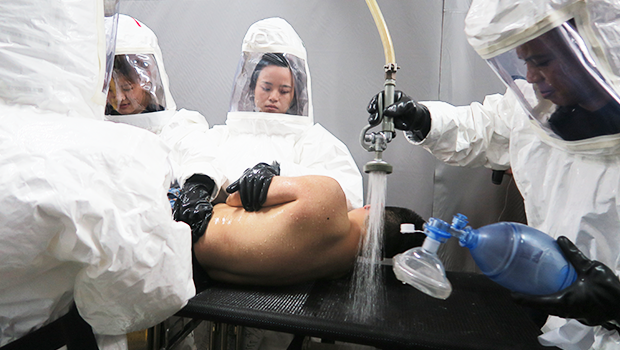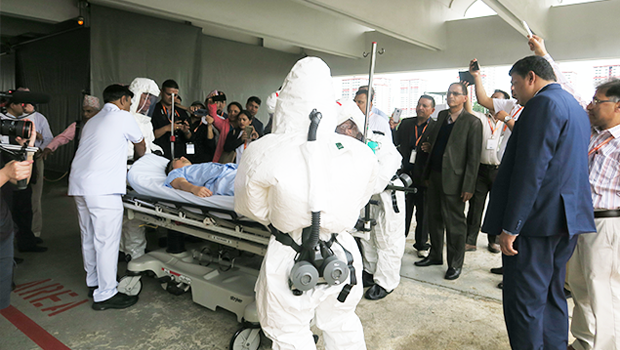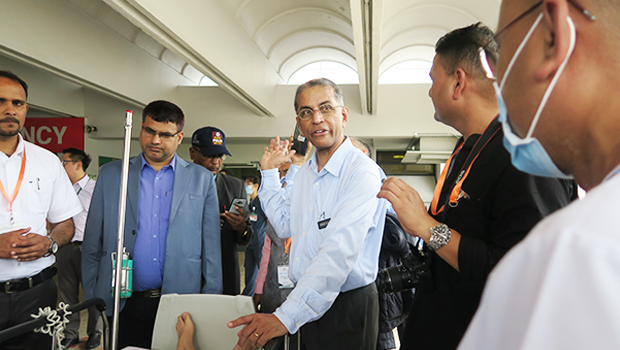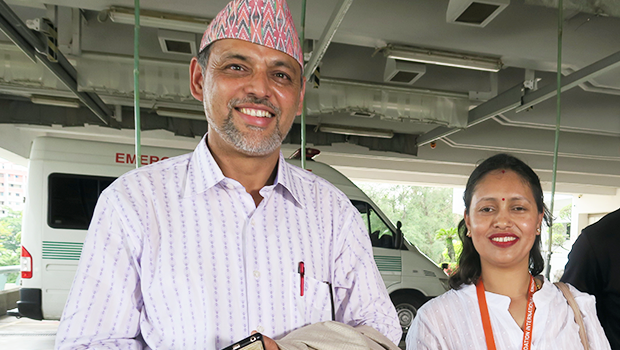Nepalese medical experts watching a simulated demonstration where a mock victim of a chemical disaster is safely transferred from the ambulance to the containment and decontamination area outside SGH’s Emergency Department.
Thirty medical experts from Nepal were recently in Singapore to be exposed to local systems of disaster management and understand how they have evolved over time.
One highlight of their week-long visit was witnessing a simulated demonstration of how a chemical disaster is managed medically.
Enacted in the decontaminated station outside the Emergency Department, they saw how quickly the hospital team assembled, safely transferred the mock patient from the ambulance to the containment area, and washed the chemicals off the patient’s body.

Medics in protective suits using water hoses to wash chemicals off the “patient’s” body.
The team was briefed by Prof Venkataraman Anantharaman, Senior Consultant, Emergency Medicine, Singapore General Hospital (SGH), who has more than 40 years’ experience in Emergency Medicine.
During the visit, organised by the International Collaboration Office of SingHealth, the visitors attended talks and workshops at SGH and toured the hospital to understand implementation of disaster organisation and infectious disease containment in a hospital setting.
They also attended briefings and disaster demonstrations at Changi Airport, Ministry of Health and the Singapore Civil Defence Force.
Training the trainers

The Nepalese trainers watching intently and taking videos of the demonstration. They will return to Nepal to train another 750 people there.
These master trainers, who included doctors and nurses, will train another 750 people when they return home.
They were picked from those trained under a special programme jointly developed by SingHealth and the Government of Nepal, and supported by Temasek Foundation International.
The programme was set up in 2017, two years after the devastating 2015 quake in Nepal which killed thousands. It aims to further equip Nepalese healthcare professionals to handle post-disaster medical recovery.
A multidisciplinary team from SGH has been training them in on-site emergency response, managing medical support at disaster sites and hospitals, and developing health service coordination systems to ensure good governance and preparedness.
Nurses and allied health professionals learn trauma nursing, critical care, orthopaedic, chest and limb physiotherapy, and post-traumatic stress counselling.
Helping Nepal develop its own system

Prof Anantharaman (centre, in white shirt) briefing the visitors and answering questions during the demonstration.
Prof Anantharaman, who is leading the programme, said its purpose is to expose senior healthcare personnel in Nepal to the Singapore system.
“It’s not for them to copy ours exactly, because that won’t work. It’s for them to learn the principles behind our own disaster management system in the healthcare sector, and to use these principles to forge a system for their own country. By using what’s available in Nepal they can create their own system, and they are very keen to do so.”
How Singapore helps
But what can a small country like Singapore with no natural disasters, teach Nepal, which has long battled them?
“We’ve learnt from local and regional disasters and active interactions with international disaster experts. We have developed and successfully implemented a disaster management system, and deployed teams to other countries to help in disasters there. We’re now able to reach out, teach and help regional countries to better manage their own disasters,” said Prof Anantharaman.
Identifying Nepal’s needs
After the 2015 earthquake, the Singapore team identified several areas where improvements could be considered in the Nepal disaster management system and worked with the Nepalese to make changes.
This included helping communities respond quickly to disasters at their doorstep, better on-site medical support, more integrated ambulance services to ferry casualties to the right hospitals, coordinated hospital management, and better networking of hospitals.
“The key to good disaster management is prompt, organised and coordinated response. That’s what we hope to achieve for Nepal with this programme. If they can be effectively achieved in Nepal, outcomes will be better for future disasters,” said Prof Anantharaman.
What the Nepalese trainers say

Mr Chuda Mani Bhandiri (left) and Prof Hira Kumari Niraula, two of the 30 medical experts from Nepal, who were here to find out more about Singapore’s disaster management systems.
For many in the team, the visit was very useful.
Associate Professor Hira Kumari Niraula, Nursing Administrator, Bir Hospital, Nepal, said, “It was very good to see the chemical disaster containment because in Nepal we don’t have chemical Hazmat kits. But now, at my hospital, we’re going to stock up on these.”
She said Nepal lacks onsite management. Deployment teams are not well equipped and tents take 4 to 6 hours to set up. “We saw the kind of field medical bags they have here which can be deployed in minutes. We’re also going to improve our roster system so that in a disaster, medics can pick up these bags and head out immediately.”
Mr Chuda Mani Bhandiri, Chief of Emergency & Disaster Management Unit and Health Emergency Operation Center at Nepal’s Ministry of Health and Population, believes the programme will help Nepalese healthcare workers build capabilities. He said much of the training will be adapted and made applicable to Nepal.
Disaster preparation is now being done on the local, provincial and federal levels. “We need more people trained and stationed in the provinces rather than going back and forth from the central region. They can also conduct regular practice drills there.”
He said there is a need for a uniform, integrated plan. “This partnership with SingHealth and Temasek Foundation International is good for us. It’s motivating and we’re grateful for it.”
